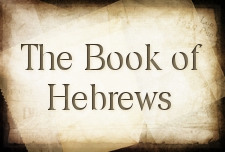What is the Main Message of Hebrews?

I am about to work through Hebrews with my Greek Exegesis class, so I am reminded of a discovery I made in Hebrews a few years ago. I am happy to follow up my post of a couple of days ago with some fresh ideas.
Recently I have discovered two effective ways in which Auctor (Latin for author of the Letter to the Hebrews) exhorts us to recognize the main theme in his book—Jesus. First, twice he calls particular attention to the One who is the real answer to his readers’ problems—Jesus. In 3:1 he writes: “Holy brothers, partakers of a heavenly calling, fix your thoughts on the Apostle and High Priest of our confession, JESUS.” And in 12:2 he writes, “Fixing our eyes on the Author and Finisher of our faith, JESUS.” These two statements, each from one of the two main sections of the book (1:1-10:18 and 10:19-13:25) are strikingly parallel in their structure.
Fix your thoughts on the Apostle and High Priest of our confession Jesus
κατανοήσατε τὸν ἀπόστολον καὶ ἀρχιερέα τῆς ὁμολογίας ἡμῶν Ἰησοῦν
Fix our eyes on the Author and Finisher of our faith Jesus
ἀφορῶντες εἰς τὸν ἀρχηγὸν καὶ τελειωτὴν τῆς πίστεως Ἰησοῦν
The two titles of Jesus in 3:1, Apostle and High Priest, are unique to Hebrews and sum up what Auctor has already said about Jesus thus far, and what he is also about to say about Him in the next few chapters. He was SENT from the Father to us (ch.1, 2), fulfilling the role of Apostle. He goes back to the Father as our representative, fulfilling the role of Priest (chs. 3-10). He compares Jesus to the prophets and the angels (“sent ones”) in chapter 1 and He is “better.” He compares Jesus to the High Priest in the following chs. (4-10) and also finds him “better.” These two titles further elucidate the primary text that he expounds in the first ten chapters: Psalm 110:1-4.
In Hebrews 12:2, the two titles Author and Finisher have to do with our faith—the main subject in Hebrews 10:19 through 12:29. He is the one who begins our faith and he also completes it! The chapter division between 11 and 12 may tend to obscure this. In chapter 11 he describes a multitude of past individuals who were faithful because they had faith. Now he concludes his argument by exhorting us to focus on the One who is the consummation of our faith, Jesus. He endured severe opposition, but in faith He looked forward to the reward: sitting at the right hand of His Father after faithfully enduring his sacrificial suffering. He is our example of faithfulness, enduring like the patriarchs because in faith he looked ahead. So we are to “look” to Him. These two titles further elucidate the primary text that Auctor expounds in Hebrews 10:19-12:29: Habakkuk 2:4.
Soon we will look at another rhetorical move that Auctor uses to focus our attention on the One who is the main message of his discourse.
Addendum
Someone looked at one of my posts, with all the Greek, and responded that she felt illiterate. Sorry. Every believer will resonate, however, with the seven glorious aspects and actions of the Son in Hebrews 1:2-4 (Holman Christian Standard Version):
- God appointed the Son heir of all things.
- God made the universe through the Son.
- The Son is the radiance of God’s glory.
- The Son is the exact expression of His nature
- The Son sustains all things by His powerful word.
- The Son made purification for our sins.
- The Son He sat down at the right hand of the Majesty on high.
- Oh wait, there’s more than seven! Actually, the two following “glories” are the implications and results of the above seven!
- The Son became higher in rank than the angels (see ch 2).
- The Son inherited a name that is superior to theirs (elaborated in 1:5-14).
Glory be to the Father—and to the Son! AMEN
Will Varner Bio
Will Varner is Professor of Bible & Greek at The Master’s College. He earned a BA from Bob Jones University, MA from Dropsie College, MDiv and ThM from Biblical Theological Seminary and EdD fromTemple University. He blogs at DrIBEX Ideas.
- 172 views


Discussion